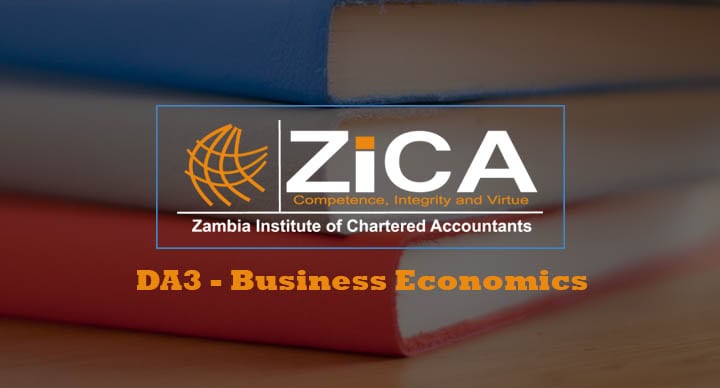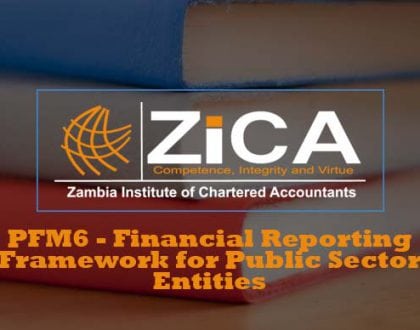DA3-Business Economics
No access plans exist.

Course Features
Course Details
DA3-Business Economics
Learning outcomes
On successful completion of D3, students should be able to:- Explain economic concepts and terminology commonly used in commerce
- Describe the role of market demand and supply in establishing prices and explain the role of government in regulating market failure in Zambia
- Describe the main forms and goals of business operating in Zambia
- Explain the theories of short and long run cost behaviour and short run profit maximisation
- Describe the role of market structure and competition in establishing profits of a business and explain the role of government in modifying markets in Zambia
- Describe the National Income and other data produced by the CSO
- Identify the factors determining the levels of National Income in Zambia
- Explain the main features of the monetary and financial environment affecting Zambian business and their likely impacts
- Identify the impact on Zambia of the international sector and of major national and international economic institutions
- Explain the role of government in stabilising and encouraging the development of the Zambian economy
| Topic | Weighting |
| Introduction to economic concepts | 5% |
| Price Theory | 10% |
| Forms of enterprise | 5% |
| Cost theory and profit maximization | 10% |
| Market structures and competition | 15% |
| National Income accounting | 5% |
| National Income determination | 15% |
| Monetary and financial environment of business | 10% |
| International sector | 15% |
| Government macroeconomic policy | 10% |
Content
-
Introduction to economic concepts
- The Economic Problem: scarcity, choice and opportunity costs
- Explain the economic problem in terms of factors of production, scarcity, choice and opportunity cost
- Production possibility frontier: causes of economic growth and reasons for inefficiency
- Illustrate the economic problem using a production possibility curve
- Market versus Planned economic solutions to the economic problem and role of privatisation and liberalisation
- Explain the features, benefits and drawbacks of command, market and mixed economics
- Explain the methods of privatisation and its benefits and draw backs
- Explain liberalisation of the economy and its benefit and drawbacks
- Encouraging economic growth and development: primary, secondary and tertiary sectors; Zambian government policies for encouragement of diversity, growth and development; factors inhibiting growth in Zambia, the information economy and growth
- Explain the benefits and drawbacks of economic growth
- Describe the stages of economic development using economic sectors and Rostow’s take off model
- Describe the main conditions needed for economic development
- Explain the consequences of the digital divide and the policies for overcoming it Economics as a social science: methods of analysis and explanation used; positive versus normative economics
- Distinguish between positive and normative statements in economic reasoning
- The Economic Problem: scarcity, choice and opportunity costs
-
Price theory
- A Market demand and supply curves: derivation of equilibrium price
- Construct a demand and supply analysis of a market
- Identify the equilibrium price demand and supply analysis of a market
- Elasticities of demand and supply
- Calculate price elasticities of demand and supply
- Causes of price instability in markets for primary goods
- Explain the factors making prices unstable in primary markets
- Price stabilisation approaches
- Evaluate methods of intervention to stabilise price
- Market failures and their regulation
- Explain the main sources of market failures and policies to deal with them
- Forms of markets and distribution networks
- Identify the forms of markets and distribution networks
- A Market demand and supply curves: derivation of equilibrium price
-
Forms of enterprise
- Legal forms of business
- Distinguish between form of organisation according to their ownership
- Identify the objectives of different organisation
- Goals of enterprises
- Explain the goals of share holders
- Legal forms of business
-
Cost theory and profit maximization
- Short run cost behaviour: fixed and variable costs and the law of eventually diminishing marginal returns
- Distinguish short run and long run in the theory of costs
- Distinguish between an economist’s and an accountant’s concept of cost
- Profit maximisation in the short run: Marginal Cost = Marginal Revenue (MC= MR) (M)
- State the assumption of profit maximisation and apply the concept to determine equilibrium output in the short run
- Long run cost behaviour: economies and diseconomies of scale
- Illustrate cost behaviour in the short run and long run
- Identify the main sources of economies and diseconomies of scale
- Explain the methods by which the firms grow
- Short run cost behaviour: fixed and variable costs and the law of eventually diminishing marginal returns
-
Market structures and competition
- A Structure, conduct, performance analysis: perfect competition, monopoly and monopolistic competition, including cartels (A)
- Evaluate the short run and long run equilibrium of firms under perfect competition, monopoly, monopolistic competition and oligopoly
- Behavioural theories of the firm: oligopoly, game theory, managerial theories (A)
- Explain behavioural theories of the firm
- Market protection policies: industrial subsidies, tariffs and quotas, monopolistic purchasing arrangements (A)
- Explain the effects of policies to regulate market competition
- Information economics: impact of reduced search costs and low variable costs of provision on market structures and pricing (A)
- Explain the effects of advanced communication technologies on the structure, conduct and performance of a market.
- A Structure, conduct, performance analysis: perfect competition, monopoly and monopolistic competition, including cartels (A)
-
National Income accounting
- Central Statistical Office (CSO) methodology of constructing measures of Zambian National Income (NI) (M)
- Explain the methods of calculating national income
- Interpretation and uses of National Income data: cross sectional and time series evaluations; difficulties (I)
- Explain the usefulness of national income statistics
- Other CSO data: Census of Production, Population and Housing; Census of Agriculture; Balance of Payments (compiled by Bank of Zambia)
- Identify other sources of data on macroeconomic activity
- Central Statistical Office (CSO) methodology of constructing measures of Zambian National Income (NI) (M)
-
National Income determination
- Aggregate demand and supply analysis of national income determination
- Explain the concepts of aggregate demand and aggregate supply
- Circular flow of income model of aggregate demand
- Explain the determination of national income in the circular flow model
- Macroeconomic equilibrium conditions: injections and withdrawals, planned expenditure =national income
- Illustrate changes to the factors affecting national income using a 45 degree model and multiple calculations.
- Keynesian multiplier theory
- Explain and apply the Keynesian multiplier theory
- The business cycle
- Explain the phases of the trade cycle
- Aggregate demand and supply analysis of national income determination
-
Monetary and financial environment of business
- Financial intermediation: main financial deficit and surplus units; functions of intermediaries; Zambian financial intermediaries and markets (including equity markets) (M)
- Explain the concept of financial intermediation
- Describe the process of financial intermediation
- Identify the financial intermediaries and their functions
- Roles of Bank of Zambia: banker to banking system and government; fiscal agency; prudential supervision of banking and financial services; foreign exchange supervision; implementation of monetary policy: goals, direct and indirect instruments of monetary policy, consequences of monetary policy for business (M)
- Explain the functions of the Bank of Zambia
- Explain the goals of monetary policy
- Explain the instruments of monetary policy
- Explain the impact of monetary policy on business
- Credit creation by commercial banks: credit multiplier; measures of money stock (monetary aggregates); impacts of bank behaviour on business (M)
- Outline the aims and functions of commercial banks
- Illustrate the process of credit creation and calculate the credit multiplier
- Explain the monetary aggregates
- Interest rate determination: calculation of bond and bill rates; main influences e.g. yield curve, inflation, risk; impact of interest rates on equity markets (M)
- Explain factors influencing interest rates
- Explain the determinants of interest rates
- Calculate interest rates, treasury bill rates and bond rates
- Explain the impact of interest rates on equity markets
- Global banking crisis: origins; consequences for banking and business; policies to resolve crisis (M)
- Explain the causes and consequences of banking crises
- Discuss the policies to resolve banking crises
- Financial intermediation: main financial deficit and surplus units; functions of intermediaries; Zambian financial intermediaries and markets (including equity markets) (M)
-
International sector
- Theories of free trade and protectionism: comparative advantage; arguments for and against protectionism (A)
- Explain the gains from free trade and its drawbacks
- Calculate absolute advantage and comparative advantage determine the gains from trade
- Forms of protectionism and cross-national integration: policies; alliances (including Southern Africa Development Community (SADC)), common markets (including Common Market for Eastern and Southern Africa (COMESA) customs unions, free trade areas and economic communities (including Economic Community of West African States (ECOWAS) (A)
- Explain the practices of protectionism, trade groupings and globalisation
- Balance of Payments: construction and characteristics of Zambian accounts; terms of trade; deficits and financing; capital flows (A)
- Identify the components of the Balance of Payments
- Explain the terms of trade
- Explain the measures used to finance and rectify the Balance of Payments deficit
- Exchange rates: calculation; determination; policies to manage exchange rates (A)
- Explain the factors that influence exchange rates
- Discuss the different types of exchange rate regimes (fixed versus floating)
- Analyse the impact of balance of payments on exchange rates and borrowing
- International financial institutions and external debt: development funding; roles of World Bank Group; International Monetary Fund; impact of external debt on balance of payments (A)
- Explain the role of international financial institutions
- Explain the impact of external debt on the Balance of Payments
- Theories of free trade and protectionism: comparative advantage; arguments for and against protectionism (A)
-
Government macroeconomic policy
- Goals of macroeconomic policy in Zambia: role of Ministry of Finance (MoF) in structural adjustment and poverty reduction; main elements of current National Development Plan (M)
- Explain the economic policy objectives of government
- Explain the role of Zambian’s Ministry of Finance
- Zambian Public Financial Management system (PFM): sources of revenue; uses of government expenditure; role of external borrowing; impact of tax on distribution and incentives; public debt management; public sector investment; Balance of Payments stabilisation (M)
- Evaluate the main fiscal and monetary policies available to governments
- Inflation and hyperinflation: measurement of inflation; causes and consequences of inflation and hyperinflation; policies to control inflation (M)
- Calculate inflation rate
- Explain the causes and consequences of inflation
- Discuss government policies to control inflation
- Unemployment: measurement of unemployment; types of unemployment; youth unemployment; costs of unemployment; policies to control unemployment (M)
- Explain the measurement of unemployment
- Explain the types of unemployment
- Discuss the costs of unemployment and government policies to control it
- Goals of macroeconomic policy in Zambia: role of Ministry of Finance (MoF) in structural adjustment and poverty reduction; main elements of current National Development Plan (M)
Format of the exam
| Section | Marks |
| Section A: 10 compulsory multiple choice questions, 2 marks each | 20 |
| Section B: Any 2 out of 3 questions on microeconomics, 20 marks each | 40 |
| Any 2 out of 3 questions on macroeconomics, 20 marks each | 40 |
| TOTAL | 100 |
Recommended reading
- ZiCA D3 Study Manual
- Griffiths, A and Wall, D, Applied Economics, 11th edition, FT Prentice Hall, 2007
This course does not have any sections.





